Har du någonsin glömt dina husnycklar och känt dig utelåst? Att bli utelåst från din WordPress-webbplats kan kännas ungefär så. Det är otroligt frustrerande, särskilt om hackare har raderat ditt administratörskonto. Men oroa dig inte, du kan komma in igen.
Tänk på din webbplats som ett hus med en hemlig bakdörr. Den bakdörren är din webbplats databas, och den nås vanligtvis med MySQL-kod. Nu kanske det låter komplicerat, men det är som en uppsättning instruktioner du kan använda för att göra ändringar i din webbplats bakom kulisserna.
I den här artikeln kommer vi att lära dig hur du använder MySQL för att skapa ett helt nytt administratörskonto för din webbplats, ungefär som att skaffa en ny nyckel till ditt hus. På så sätt kan du låsa ute hackarna och ta tillbaka kontrollen.
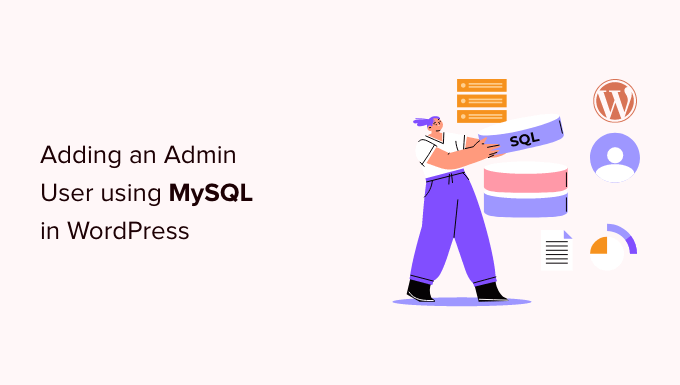
Varför lägga till en administratörsanvändare i WordPress-databasen via MySQL?
Vi stötte en gång på ett problem där en användares webbplats hackades, och deras administratörskonto raderades från databasen. Detta låste dem ute från sin WordPress-webbplats.
Vi kunde hjälpa dem att få åtkomst till sin webbplats genom att skapa en ny administratörsanvändare direkt i WordPress-webbplatsen. Vi gjorde det med phpMyAdmin, ett webbaserat verktyg som låter dig hantera MySQL-databaser med din webbläsare.
Om du befinner dig utelåst från ditt WordPress-adminområde på grund av hackare eller helt enkelt för att du glömt ditt lösenord, kan du göra detsamma.
Du bör dock alltid göra en säkerhetskopia av din databas innan du utför några MySQL-redigeringar. Sedan, när du kan logga in på din webbplats igen, kan du behöva följa vår nybörjarguide för att åtgärda din hackade WordPress-webbplats.
Med det sagt, låt oss titta på hur man lägger till en administratörsanvändare i WordPress-databasen via MySQL.
Lägga till en administratörsanvändare i WordPress-databasen med phpMyAdmin
phpMyAdmin är förinstallerat hos de flesta bästa WordPress-värdföretag. Du hittar det i databassektionen på din värdkontos cPanel-instrumentpanel.
Här är en skärmdump från kontrollpanelen för Bluehost:
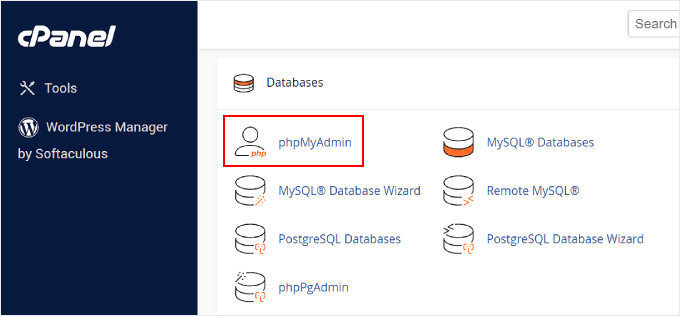
Att klicka på ikonen öppnar phpMyAdmin-gränssnittet. Du behöver välja din WordPress-databas från vänster kolumn.
Därefter kommer phpMyAdmin att visa alla tabeller i din WordPress-databas. Du kommer att göra ändringar i tabellerna wp_users och wp_usermeta.
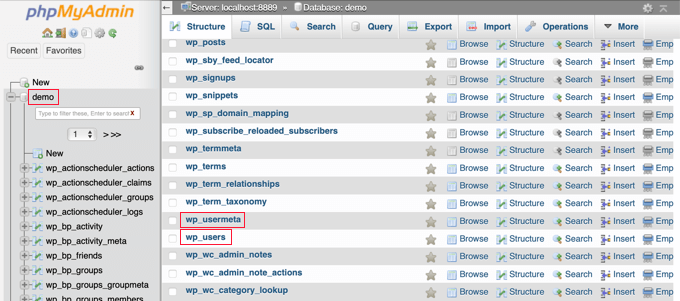
Lägga till en användare i tabellen wp_users
Först måste du hitta tabellen wp_users och klicka på den. Detta visar de användare som för närvarande finns i tabellen.
Lägg märke till i skärmdumpen nedan att det finns två användar-ID:n i vår demo-webbplats tabell, 1 och 2. När vi skapar en ny användare för vår demosida måste detta ID vara unikt, så vi skriver siffran 3.
Du behöver klicka på fliken 'Infoga' högst upp på skärmen så att du kan infoga informationen för en ny administratörsanvändare.
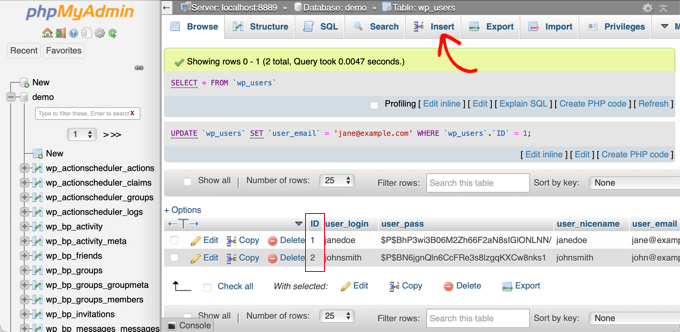
Lägg till följande information i fälten på Infoga-formuläret:
ID: välj ett unikt nummer (i vårt exempel använder vi 3)user_login: användarnamnet som kommer att användas vid inloggninguser_pass: lägg till ett lösenord och se till att välja MD5 i funktionsmenyn (se skärmdumpen nedan)user_nicename: användarens fullständiga namn eller smeknamnuser_email: användarens e-postadressuser_url: din webbadressuser_registered: välj datum och tid då användaren registrerades med hjälp av kalendernuser_activation_key: lämna tomtuser_status: ställ in detta till 0display_name: användarens fullständiga namn eller visningsnamn
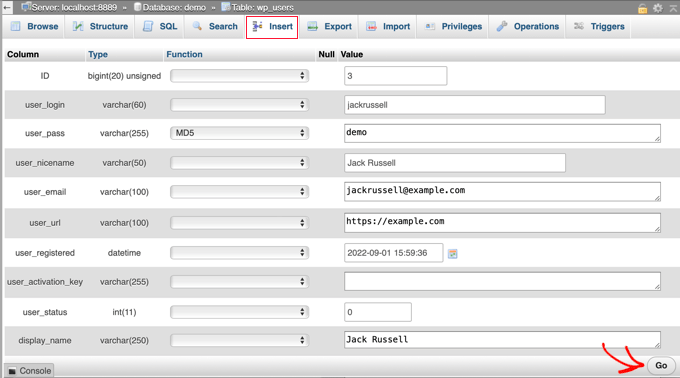
När du är klar, se till att klicka på knappen 'Gå' för att spara den nya användaren.
Lägga till en användare i tabellen wp_usermeta
Nu behöver du hitta tabellen wp_usermeta och klicka på den. Därefter bör du klicka på fliken 'Infoga' som du gjorde i föregående steg.
Därefter behöver du lägga till följande information i infogningsformuläret:
unmeta_id: lämna detta tomt (det kommer att genereras automatiskt)user_id: användar-ID:t du använde i föregående stegmeta_key: detta bör varawp_capabilitiesmeta_value: infoga detta:a:1:{s:13:"administrator";s:1:"1";}
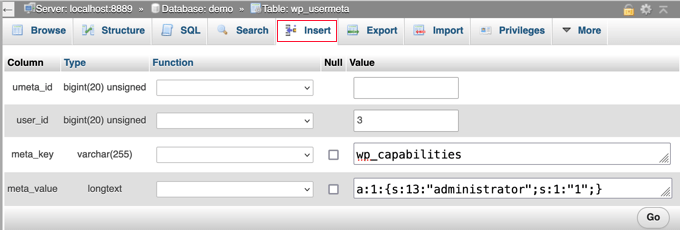
Därefter, när du skrollar ner, bör du hitta fält för en andra rad. Du måste ange följande information:
unmeta_id: lämna detta tomt (det kommer att genereras automatiskt)user_id: användar-ID:t du använde i de föregående stegenmeta_key: du behöver angewp_user_levelmeta_value: 10

När du har angett informationen i fälten måste du klicka på knappen 'Gå'. Grattis, du har skapat ett nytt administratörsanvändarnamn!
Nu bör du kunna logga in på ditt WordPress adminområde med det användarnamn och lösenord du angav för denna användare.
Så fort du loggar in måste du navigera till Användare » Alla användare, klicka sedan på användarnamnet du just skapade.
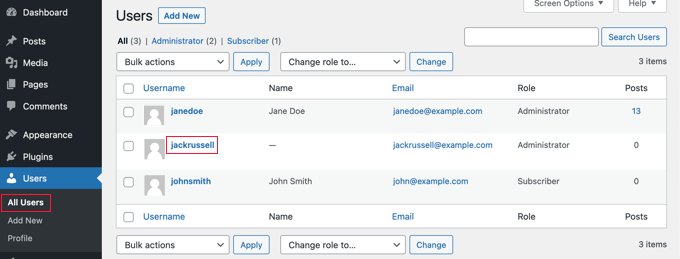
Nu, utan att ändra något, skrolla till botten av sidan och klicka på knappen 'Spara'.
Detta gör att WordPress kan rensa upp användaren du just skapade och lägga till ytterligare information som behövs.
Lägga till en administratörsanvändare i WordPress-databasen med en SQL-fråga
Om du är utvecklare kan du påskynda processen genom att använda kod.
Infoga helt enkelt denna SQL-fråga i din databas:
INSERT INTO `databasename`.`wp_users` (`ID`, `user_login`, `user_pass`, `user_nicename`, `user_email`, `user_url`, `user_registered`, `user_activation_key`, `user_status`, `display_name`) VALUES ('3', 'demo', MD5('demo'), 'Your Name', 'test@example.com', 'http://www.example.com/', '2022-09-01 00:00:00', '', '0', 'Your Name');
INSERT INTO `databasename`.`wp_usermeta` (`umeta_id`, `user_id`, `meta_key`, `meta_value`) VALUES (NULL, '3', 'wp_capabilities', 'a:1:{s:13:"administrator";s:1:"1";}');
INSERT INTO `databasename`.`wp_usermeta` (`umeta_id`, `user_id`, `meta_key`, `meta_value`) VALUES (NULL, '3', 'wp_user_level', '10');
Se till att du ändrar 'databasnamn' till den databas du arbetar med.
Glöm inte heller att ändra de andra värdena till de du vill ha för den nya användaren, som vi förklarade i den första metoden.
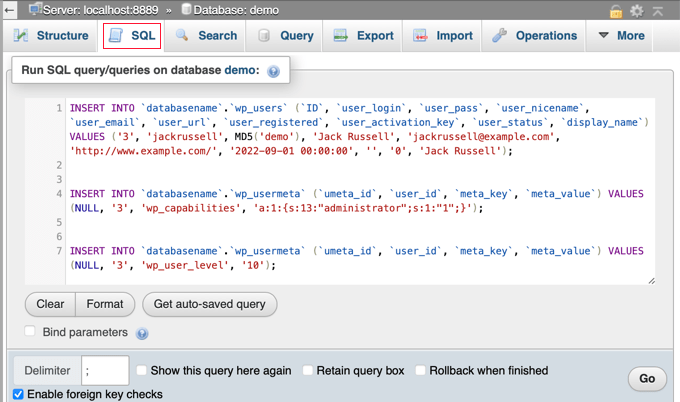
Experthandledare om vad du ska göra när du är utelåst från WordPress-administrationen
Nu när du vet hur du lägger till en administratörsanvändare via MySQL, kanske du vill se några artiklar om hur du fixar din webbplats när du är utelåst från WordPress-adminområdet.
- Vad du ska göra när du är utelåst från WordPress-admin (wp-admin)
- Hur du använder WordPress återställningsläge
- Hur man återställer ett WordPress-lösenord från phpMyAdmin
- Hur man avblockerar Limit Login Attempts i WordPress
- Hur du inaktiverar alla plugins när du inte kan komma åt WP-Admin
- Hur man fixar WordPress White Screen of Death (steg för steg)
- Hur du åtgärdar kritiska fel i WordPress (steg för steg)
- Hur man fixar problemet med att WordPress inloggningssida uppdateras och omdirigeras
- Hur du åtgärdar felet vid upprättande av databanslutning i WordPress
- Hur du enkelt fixar felet "Den här webbplatsen kan inte nås" i WordPress
Vi hoppas att den här handledningen hjälpte dig att lära dig hur du lägger till en administratörsanvändare i WordPress-databasen via MySQL. Du kanske också vill se vår ultimata WordPress-säkerhetsguide eller vår lista över vanliga WordPress-fel och hur du åtgärdar dem.
Om du gillade den här artikeln, prenumerera då på vår YouTube-kanal för WordPress-videoguider. Du kan också hitta oss på Twitter och Facebook.





zohaib
Tack så mycket, ja, jag fick mitt problem löst och det berodde på den roll som tilldelats mitt användarnamn. Skål
Bichir Mihail
Tack, verkligen hjälpsamt
Rastislav Nichta
Verkligen en mycket enkel och tydlig guide till hur man skapar en användare via MYSQL Wordpress-databasen, tack.
Mary Janis
Denna information är föråldrad eftersom HG-formatet har ändrats helt. Var i hela friden finns wp_user?
Susan Marshall VA
Tack så mycket för detta. Hade precis en klient som låste sig ute från sin sajt och jag kunde få henne tillbaka med dessa instruktioner.
Kumar Mritunjay
Jag har använt detta på mina webbplatser. Fungerar som en charm... väldigt lätt att följa!
Tack för denna fantastiska tidsbesparande teknik.
sara asadiha
i did everything u said, but it did not work what else should i do?
what else should i do?
Peter Gough
Thanks for this. Really helped when I was locked out of Wordpress
Michael Sineni
Jag har ändrat min administratörsåtkomst till redigerare eftersom jag försökte ändra rollbehörigheter för att redigera gravity forms. Plötsligt ser jag inte längre redigera cornerstone eller har åtkomst!! HJÄLP!
Ayesi
Verkligen bra, allt fungerar perfekt, tack så mycket!!
Stella
Tack så mycket! Detta räddade min dag. Phu!
Nilo Velez
Jag vet inte om det är en uppdatering av WordPress datastruktur, men jag har precis stött på en webbplats där jag var tvungen att ange wp_options meta_key-värdena som:
[table_prefix]capabilities istället för wp_capabilities
[table_prefix]user_level istället för wp_user_level
Jag lämnar detta här då det kan vara till hjälp.
Takis Pan
Du, herre, är fantastisk!
Jag antar att den använder databasprefixet, men om webbplatsen har flyttats, eller om någon har ändrat prefixet från "wp_" till något annat, bör behörigheter och user_level ändras därefter.
Abraham Quilca
Tack, den här kommentaren hjälpte mycket.
Jag var tvungen att dubbelkolla och hämta det exakta värdet för table_prefix från vår wp-config.php-fil. Våra meta_key-värden var korrekta förutom versalisering. Jag tror att vissa hostingföretag med WordPress-installationer med ett klick kommer att sätta sina egna table_prefixes, så se till att kontrollera det också.
Cheryl
detta fungerade för mig också, tack Abraham
Loren Helgeson
Jag har använt detta på tre olika webbplatser hittills. Fungerar som en charm!
Tack för att du sparade så mycket tid.
Steve Day
BRILLIANT!!!
Thank you – saved my day
Kirst
Det verkar som om det har skett en databasändring i den senaste versionen av WP, så detta inlägg kan behöva uppdateras.
Det har varit en fantastisk resurs, tack!
Loren Helgeson
Jag kan inte verifiera detta med tidigare versioner av Wordpress, men jag testade precis detta med den senaste versionen av Wordpress, och det fungerade bra för mig. Kan någon annan också bekräfta om detta var en tillfällighet?
Abid
Jag har gjort samma SQL-frågor för att skapa en administratörsanvändare. Användaren skapades och loggades in men visar felmeddelandet "Tyvärr, du har inte behörighet att komma åt den här sidan". Vänligen hjälp mig med detta.
Jade
TACK SÅ MYCKET! Jag hade ett problem med WooCommerce Product Vendors, där jag ansökte som leverantör medan jag var inloggad som administratör. Från den punkten kunde jag inte logga in och jag fick ett meddelande "Du kommer att meddelas när ditt konto har godkänts" O_o
Previously I had to re-install WP because of this!!! Now I found your post and it was such a help!!! Thank you so much for sharing this x
x
Ben
Fungerade inte alls för mig. Jag får ett "FEL: Felaktigt användarnamn eller lösenord."
Ja ja, jag har kollat det. Lösenord och användare är korrekta.
Så vad nu? Jag hade tidigare administratörsåtkomst men har nu bara en lägre grundläggande nivå som inte visar användarinställningarna.
Loren Helgeson
Detta fungerade perfekt på de två senaste webbplatserna jag har behövt använda det på.
SHAILENDRA RAJAVARAM
Fantastiskt... räddade mig från massor av problem, liksom för andra problem. Jag märkte att av någon anledning alla administratörer på min webbplats blev något annat...
STOR HJÄLP !!
Killarna som diskuterade wp_prefixes.....perfekt....
Ah !!!
Werner Ullrich
För mig är det ett mycket hjälpsamt inlägg. Jag har modifierat detta SQL-skript och återaktiverat min dörr till administratörsinloggningen på min wordpress-hemsida. Tack.
Werner Ullrich
Smithg0
Okej, den här YouTube-videon är mycket förbättrad jämfört med den förra, den här har en behaglig bildfunktion samt ljud.
Jerry L
Jag ville ändra flera "Nicename"-poster till andra värden än användarens inloggningsnamn. Från PhpMyAdmin exporterade jag tabellen "wp_users".
Sedan gjorde jag nödvändiga ändringar i min kodredigerare.
Sedan, efter att ha sparat en säkerhetskopia av den ursprungliga användartabellen och hela databasen, "importerade" jag bara "wp_users"-tabellen tillbaka till databasen med hjälp av PhpMyAdmin.
Fungerade bra för mig.
Brad
Fungerade som en charm! Tack!
kali
Jag följde detta och kunde logga in men kan inte gå till instrumentpanelen. Jag får detta felmeddelande: Du har inte tillräckliga behörigheter för att komma åt den här sidan.
Oleg
Jag har samma problem.
Eileen
Jag hade samma problem men i wp_usermeta där vi får veta att skriva:
meta_value – infoga detta: a:1:{s:13:”administrator”;s:1:”1″;}
Jag ändrade värdet till:
a:1:{s:13:”administrator”;b:1;}
och det fungerade. Jag hittade detta värde i motsvarande värde längre upp i tabellen för det ursprungliga administratörskontot. Kontrollera din tabell och se om det finns några andra tidigare administratörer, och kopiera samma värde (bara för att vara säker på att det skiljer sig från mitt värde).
Mark P
Det här fungerade för mig, tack!
Ardestani
Det fungerar, tack, verkligen tack
Jason Coleman
This didn’t work for me
Daniel Payne
För att detta ska fungera med den senaste WordPress 4.4.2 var jag tvungen att uppdatera meta_key-namnen eftersom min WordPress-installation använde ett tabellprefix på wp_brnq_ istället för det vanliga wp_-prefixet.
Rose
Vad menar du? Detta fungerar inte för mig heller.
Robert Drummond
Tack för detta! Det räddade mig från ett felaktigt plugin som skrev över mitt administratörs-konto i användartabellen!
Nadia
Jag håller just nu på att fixa min mammas hemsida för hennes företag och jag är lite av ett wordpress-dummy. Jag kunde inte logga in ordentligt för att hon skickade mig fel lösenord. Efter tre misslyckade försök stod det att jag skulle titta i datan. Meddelande: 'Användarnamn eller lösenord är inte korrekt. Vänligen kontrollera din data.'
Jag följde stegen här och jag följde alla dessa steg mycket noggrant, men ändå, med mitt nya användarnamn och lösenord, kan jag inte logga in. Min prefix var annorlunda än wp_ vad den här artikeln angav, så jag ändrade prefixet också – men kommer inte igenom. Nu är jag utelåst till imorgon.
What happened, can someone maybe help me / explain me what I did wrong and how can I fix this. I really promised my mom to build her website, and it needs to be updated really soon!
Joe Harkins
du gjorde ett bra jobb steg för steg tills du kom till
“meta_key – detta bör vara wp_capabilities”
Vad betyder "bör vara" i det här sammanhanget? Betyder det att det redan ska stå det i det fältet, kanske genererat från något tidigare? Om det inte finns där, vad krävs?
Det finns ett rullgardinsfält till höger om meta_key. Filnamnet "wp_capabilities" finns inte som ett val. Det finns ett tomt fält till höger om det. Ska jag klistra in wp_capabilities där? Finns det ett värde av det namnet någonstans som jag borde lägga in i det fältet?
Och jag ser mer problem framför mig. Du säger "infoga en ny rad".
Jag tolkar ordet 'infoga' som ett verb. Var och hur gör jag det? Jag är redan på sidan Infoga. Det står inget på den som säger "Infoga ny rad".
När jag tittar längre ner – hela vägen till botten – hoppar över nästa avsnitt (som jag får höra att jag ska göra) ser jag ett fält som säger "Infoga som en ny rad".
Men “infoga en ny rad” och att bli tillsagd att gå till ett fält som innehåller frasen “Infoga som en ny rad” är inte allt samma sak.
och det finns en markerad ruta som säger "ignorera" precis ovanför den. Vad är poängen med att gå vidare om den rutan fortfarande är markerad som ignorera – och är "infoga en ny rad" samma sak som "infoga en ny rad?"
Och jag ser samma "borde vara" förvirring igen i nästa uppsättning instruktioner.
Men jag sitter fast vid det första "borde" eftersom jag är bokstavlig. Vänligen förtydliga?
Jeff
Hej Joe,
“meta_key – detta borde vara wp_capabilities” betyder att meta_key-värdet (textrutan i phpmyadmin) ska vara wp_capabilities
När han hänvisar till att infoga en ny rad kan du göra det genom att klicka på infoga i navigeringen högst upp i phpmyadmin. Den här handledningen förutsätter att du redan har gjort den första infogningen och är på fliken bläddra.
Rik
Jag hade en installation med flera webbplatser. Efter att ha gjort detta kan jag komma åt båda webbplatserna, men jag har ingen nätverksadministratörskapacitet och ingen pluginhantering… Under "Mina webbplatser" ser jag mina två webbplatser, men ingen "Nätverk"-alternativ. På den vertikala menyområdet för min webbplats verkar jag ha allt utom "Plugins".
Verkar som att jag inte har administration över mitt WP-nätverk för flera webbplatser?
sapere aude
that was awesome! thanks.
thanks.
Bouasone
Många tack, det var mycket hjälpsamt
Russ
Tack för den utmärkta handledningen! Jag kunde logga in framgångsrikt.
Arpan Das
Tack så mycket. Fungerar bra…
Rodolfo
Detta räddade mitt liv idag – tack!
Phil
Detta fungerade för mig med följande ändring: wp_capabilities-värdet måste hämtas från en annan administratörsanvändares rad eftersom den hade ytterligare behörigheter eller vad de nu är. Kopiera värdena i så fall från en befintlig användare om det behövs
Reid Walley
Om du har gått igenom alla steg och du FORTFARANDE får felmeddelandet "Du har inte tillräckliga behörigheter för att komma åt den här sidan" när du försöker logga in...
Jag var tvungen att ersätta den första exempelns meta_key (wp_capabilities) med min egen prefix: ändra wp_capabilities till vaddittprefixär_capabilities
Samma med det andra meta_key-exemplet (wp_user_level). Jag ändrade det till min specifika prefix: ändra wp_user_level till vaddittprefixär_user_level
Yoana
Thanks, that fixed it
Terry Hale
Such a helpful article. Perfectly done, easy to understand. Thanks for the time you spent putting it together.
Andre
Detta har varit mycket hjälpsamt för mig vid flera tillfällen. Tack för att du sammanställt detta!!!
2046
för de som fortfarande får "Du har inte tillräckliga behörigheter för att komma åt den här sidan.".
du kanske vill kontrollera att wp_capabilities och sånt följer ditt databasprefixnamn..
som om din normala wp_usersmeta har blab787_usersmeta så kommer wp_capabilities att vara blab787_capabilities etc.
Lydia B
Tack, din lösning på felmeddelandet "du har inte tillräckliga behörigheter" fungerade perfekt för mig.
Terry Hale
Thanks for posting! I ran into that problem, and you solved it.
Cristian Deraco
Tack!!! det fungerade för mig ja!
Rony
Jag kan inte se tabellen med användarinformation, har du någon idé?
Denny
Fantastisk genomgång. Detta stämmer perfekt med flera versioner av phpmyadmin så ignorera skillnaderna i skärmdumparna. Tack för texten!
-D
Denny
WordPress 3.6.1. Jag kommer att testa detta med 4 och bekräfta också.
Ludwik C. Siadlak
Samma här, i september 2015 får jag felmeddelandet "Du har inte tillräckliga behörigheter för att komma åt den här sidan." efter att ha använt SQL-koden som tillhandahålls. Vilket är konstigt, eftersom den här artikeln bara är 6 månader gammal!
Harm
Jag följde dina instruktioner till punkt och pricka men något gick fel (vet inte vad) och nu har jag inte tillgång till min webbplats. Jag får meddelandet: databasfel.
Kan jag ångra ändringarna jag gjorde? Snälla hjälp.
Kiel
allt jag behövde göra var att återställa metadata tillbaka till admin och det fungerade utmärkt. Tack för artikeln.
Matthew Galvin
Ganska värdelös i > version 3. Fin början dock.
Chris Hewlett
Hej, jag grävde lite djupare i problemet och upptäckte att befintliga poster i tabellen "usermeta" hade ett prefix som var unikt för min webbplats. Mina WordPress-tabeller börjar alla med ar_, och när jag redigerade dessa 2 rader för att återspegla det, var min inloggning komplett, med alla privilegier.
Med vänliga hälsningar,
Chris
Chris Hewlett
Hej, och tack för ovanstående text om detta ämne. Jag har blivit utelåst från min lokala webbplats (XAMPP) och andra artiklar jag har läst handlar om att ändra befintligt administratörslösenord med phpMyAdmin. Jag hade ingen framgång med de metoderna.
Jag följde dina instruktioner ovan och inloggningsskärmen accepterade inloggningsuppgifterna.
Tyvärr omdirigerades jag till domain//wp-admin/profile.php och frasen “Du har inte tillräckliga behörigheter för att komma åt den här sidan”.
Från webbplatsens frontend kan jag se att jag är inloggad, men när jag klickar på Dashboard visas samma fras.
Har du några förslag som skulle ge mig tillgång?
Tack på förhand,
Chris
Abishai
Hej, försökte fixa det genom att följa det till punkt och pricka, men när jag försöker logga in: url/wp-admin tar mig till en url/25/ sida som tidigare. Undrar vad jag gjorde fel. Vänligen ge råd. Tack på förhand.